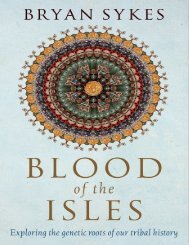Create successful ePaper yourself
Turn your PDF publications into a flip-book with our unique Google optimized e-Paper software.
simply existed, for <strong>the</strong> most part, <strong>in</strong> <strong>the</strong> perpetual now. He does not care if people fail to understand what he<br />
did <strong>in</strong> <strong>the</strong> woods. He didn’t do it for us to understand. He wasn’t try<strong>in</strong>g to prove a po<strong>in</strong>t. <strong>The</strong>re was no po<strong>in</strong>t.<br />
“You’re just <strong>the</strong>re,” Knight said. “You are.”<br />
Tenz<strong>in</strong> Palmo, who was born Diane Perry, near London, was only <strong>the</strong> second Western woman to become<br />
a Tibetan Buddhist nun. Long retreats are still commended <strong>in</strong> Buddhism, and <strong>the</strong> current Dalai Lama wrote<br />
that a life of seclusion is “<strong>the</strong> highest form of spiritual practice.” Palmo felt immensely drawn to solitude,<br />
and <strong>in</strong> 1976, when she was thirty-three years old, she moved <strong>in</strong>to a remote cave <strong>in</strong> <strong>the</strong> Himalayas of<br />
nor<strong>the</strong>rn India. She ate one meal a day—supplies were occasionally delivered to her—and lived through<br />
<strong>in</strong>tense high-alp<strong>in</strong>e w<strong>in</strong>ters, spend<strong>in</strong>g most of her time meditat<strong>in</strong>g. A seven-day blizzard once blocked her<br />
cave entrance, threaten<strong>in</strong>g asphyxiation.<br />
Palmo rema<strong>in</strong>ed <strong>in</strong> <strong>the</strong> cave for twelve years. She never once lay down; she slept, sitt<strong>in</strong>g up, <strong>in</strong>side a small<br />
wooden meditation box. Her solitude, she said, was “<strong>the</strong> easiest th<strong>in</strong>g <strong>in</strong> <strong>the</strong> world.” Not for a moment did<br />
she want to be anywhere else. She overcame all fear of death, she <strong>in</strong>sisted, and felt liberated. “<strong>The</strong> more you<br />
realize, <strong>the</strong> more you realize <strong>the</strong>re is noth<strong>in</strong>g to realize,” she said. “<strong>The</strong> idea that <strong>the</strong>re’s somewhere we have<br />
got to get to, and someth<strong>in</strong>g we have to atta<strong>in</strong>, is our basic delusion.”<br />
<strong>The</strong> British naturalist Richard Jefferies spent much of his short life—he died of tuberculosis <strong>in</strong> 1887, at<br />
age thirty-eight—walk<strong>in</strong>g alone <strong>in</strong> <strong>the</strong> woods of England. Some of his ideas seemed to parallel Knight’s.<br />
Jefferies wrote, <strong>in</strong> his autobiography <strong>The</strong> Story of My Heart, that <strong>the</strong> type of life celebrated by society, one<br />
of hard work and unceas<strong>in</strong>g chores and constant rout<strong>in</strong>e, does noth<strong>in</strong>g but “build a wall about <strong>the</strong> m<strong>in</strong>d.”<br />
Our whole lives, Jefferies said, are wasted travel<strong>in</strong>g <strong>in</strong> endless small circles; we are all “cha<strong>in</strong>ed like a horse<br />
to an iron p<strong>in</strong> <strong>in</strong> <strong>the</strong> ground.” <strong>The</strong> richest person, Jefferies believed, is <strong>the</strong> one who works least. “Idleness,”<br />
he wrote, “is a great good.”<br />
For Jefferies, like Knight, <strong>the</strong> desire to be alone was an irresistible tug. “My m<strong>in</strong>d required to live its own<br />
life apart from o<strong>the</strong>r th<strong>in</strong>gs,” wrote Jefferies. In solitude, he said, he could ponder ideas that allowed him to<br />
“go higher than a god, deeper than prayer”; <strong>the</strong>re was noth<strong>in</strong>g greater than to stand alone, “bare-headed<br />
before <strong>the</strong> sun, <strong>in</strong> <strong>the</strong> presence of <strong>the</strong> earth and air, <strong>in</strong> <strong>the</strong> presence of <strong>the</strong> immense forces of <strong>the</strong> universe.”<br />
But isolation has a razor’s edge. For o<strong>the</strong>rs, for those who do not choose to be alone—for prisoners and<br />
hostages—a loss of one’s socially created identity can be terrify<strong>in</strong>g, a plunge <strong>in</strong>to madness. Psychologists<br />
call it “ontological <strong>in</strong>security,” los<strong>in</strong>g your grip on who you are. Edward Abbey, <strong>in</strong> Desert Solitaire, a<br />
chronicle of two six-month st<strong>in</strong>ts as a ranger <strong>in</strong> Utah’s Arches National Monument, said that be<strong>in</strong>g solitary<br />
for a long time and fully attuned to <strong>the</strong> natural world “means risk<strong>in</strong>g everyth<strong>in</strong>g human.” Those who fear<br />
this will feel only lonel<strong>in</strong>ess, <strong>the</strong> pa<strong>in</strong> of social isolation, ra<strong>the</strong>r than experienc<strong>in</strong>g solitude, which can be by<br />
turns exhilarat<strong>in</strong>g and turbulent.<br />
“I was never lonely,” said Knight. He was attuned to <strong>the</strong> completeness of his own presence ra<strong>the</strong>r than to<br />
<strong>the</strong> absence of o<strong>the</strong>rs. Conscious thought was sometimes replaced with a sooth<strong>in</strong>g <strong>in</strong>ternal humm<strong>in</strong>g. “Once<br />
you taste solitude, you don’t grasp <strong>the</strong> idea of be<strong>in</strong>g alone,” he said. “If you like solitude, you’re never alone.<br />
Does that make sense? Or is that one of those koan th<strong>in</strong>gies I’m do<strong>in</strong>g aga<strong>in</strong>?”<br />
In an attempt to ga<strong>in</strong> some empirical understand<strong>in</strong>g of solitude, a cognitive neuroscientist at New York<br />
University placed more than twenty Buddhist monks and nuns <strong>in</strong>side magnetic resonance imag<strong>in</strong>g mach<strong>in</strong>es,<br />
track<strong>in</strong>g blood flow to <strong>the</strong>ir bra<strong>in</strong>s while <strong>the</strong>y meditated. O<strong>the</strong>r neuroscientists conducted similar studies.<br />
<strong>The</strong> results rema<strong>in</strong> prelim<strong>in</strong>ary, but it appears that when <strong>the</strong> human bra<strong>in</strong> experiences a self-consciously<br />
chosen silence, as opposed to sleep, <strong>the</strong> bra<strong>in</strong> does not slow down. It rema<strong>in</strong>s as active as ever. What
















